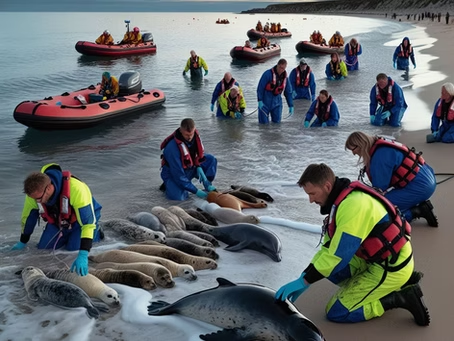The Vital Work of Marine Mammal Rescue and Rehabilitation
As a frontline marine mammal biologist, I’ve witnessed firsthand how rescue and rehabilitation programs serve as crucial interventions for individual animals while contributing significantly to broader ocean conservation. These initiatives address the devastating consequences of human impacts—from entanglement in fishing gear to pollution-related illnesses—providing medical care, rehabilitation, and ultimately a second chance at life for vulnerable marine mammals. Beyond individual animal welfare, these efforts generate invaluable scientific data that helps monitor ocean health, identify emerging threats, and develop effective conservation strategies. The work represents both an ethical responsibility toward species affected by human activities and a practical investment in understanding and protecting marine ecosystems.
Why Marine Mammal Rescue Matters
Rescue programs deliver impact at multiple levels, from individual animal welfare to global conservation science.
Impact on Individual Animals
Each rescued animal represents a life saved from suffering caused primarily by human activities. Whether disentangling a whale from fishing gear, rehabilitating a malnourished seal, or treating a dolphin with infection, these interventions provide direct, life-saving care to individuals who would otherwise perish painfully.
Broader Ecosystem Benefits
Rescue programs generate critical data about ocean health through biological sampling, disease surveillance, and documentation of human impacts. This information helps identify emerging threats like harmful algal blooms, contaminant levels, and changing prey availability that affect entire ecosystems.
Human Responsibility
Since most strandings result from human activities—fishing gear entanglement, vessel strikes, pollution, and habitat disturbance—we have an ethical obligation to mitigate these impacts and assist affected animals. Rescue efforts represent our commitment to responsible ocean stewardship.
Common Reasons Marine Mammals Need Rescue
- Entanglement in Fishing Gear: A leading cause of injury and mortality where animals become trapped in nets, lines, and traps
- Disease and Starvation: Often related to pollution, habitat degradation, or changing ocean conditions
- Vessel Strikes: Collisions with boats and ships causing traumatic injuries
- Human Interactions: Harassment, pollution ingestion, and disturbance from coastal activities
- Natural Causes: Maternal separation, predation injuries, and disease outbreaks
The Rescue Process: From Call to Release
Successful rehabilitation requires coordinated effort through multiple specialized stages.
Initial Response
Trained teams conduct beach assessments, perform initial medical evaluations, and stabilize animals for transport. This critical first response determines appropriate care levels and transport options.
Medical Treatment
Animals receive comprehensive veterinary care including diagnostics, wound management, fluid therapy, and medications. Each treatment plan is tailored to individual needs and species requirements.
Rehabilitation and Release
Patients progress through recovery pools, regain strength, and demonstrate hunting capabilities before undergoing pre-release health assessments. Successful candidates are returned to appropriate habitats with post-release monitoring when possible.
Challenges Faced by Rescue Teams
Marine mammal rescue presents unique difficulties that require specialized approaches.
Unpredictable Nature of Strandings
Response teams must be prepared for anything from single animals to mass strandings across remote locations, often in challenging weather conditions.
Resource Limitations
Funding constraints, limited facility space, and specialized equipment needs create constant challenges for maintaining response capabilities.
Environmental Hazards
Teams work in dynamic coastal environments with dangerous surf conditions, extreme weather, and logistical complications.
How Research Supports Rescue Efforts
Scientific integration enhances both individual animal care and conservation outcomes.
Health Monitoring
Regular assessment protocols track patient progress while contributing data to population health databases.
Data Collection
Biological samples, photographs, and medical records become valuable resources for understanding diseases and threats.
Informing Conservation Strategies
Rescue data directly influences management decisions regarding fishing regulations, vessel speed zones, and habitat protection measures.
How to Support Marine Mammal Rescue
- Volunteering: Assist with monitoring, fundraising, or outreach programs
- Donations: Support medical supplies, equipment, and facility operations
- Advocacy: Promote policies that reduce ocean threats and protect marine habitats
- Education: Learn proper wildlife viewing guidelines and share with others
- Reporting: Immediately contact authorized responders when encountering marine mammals in distress

